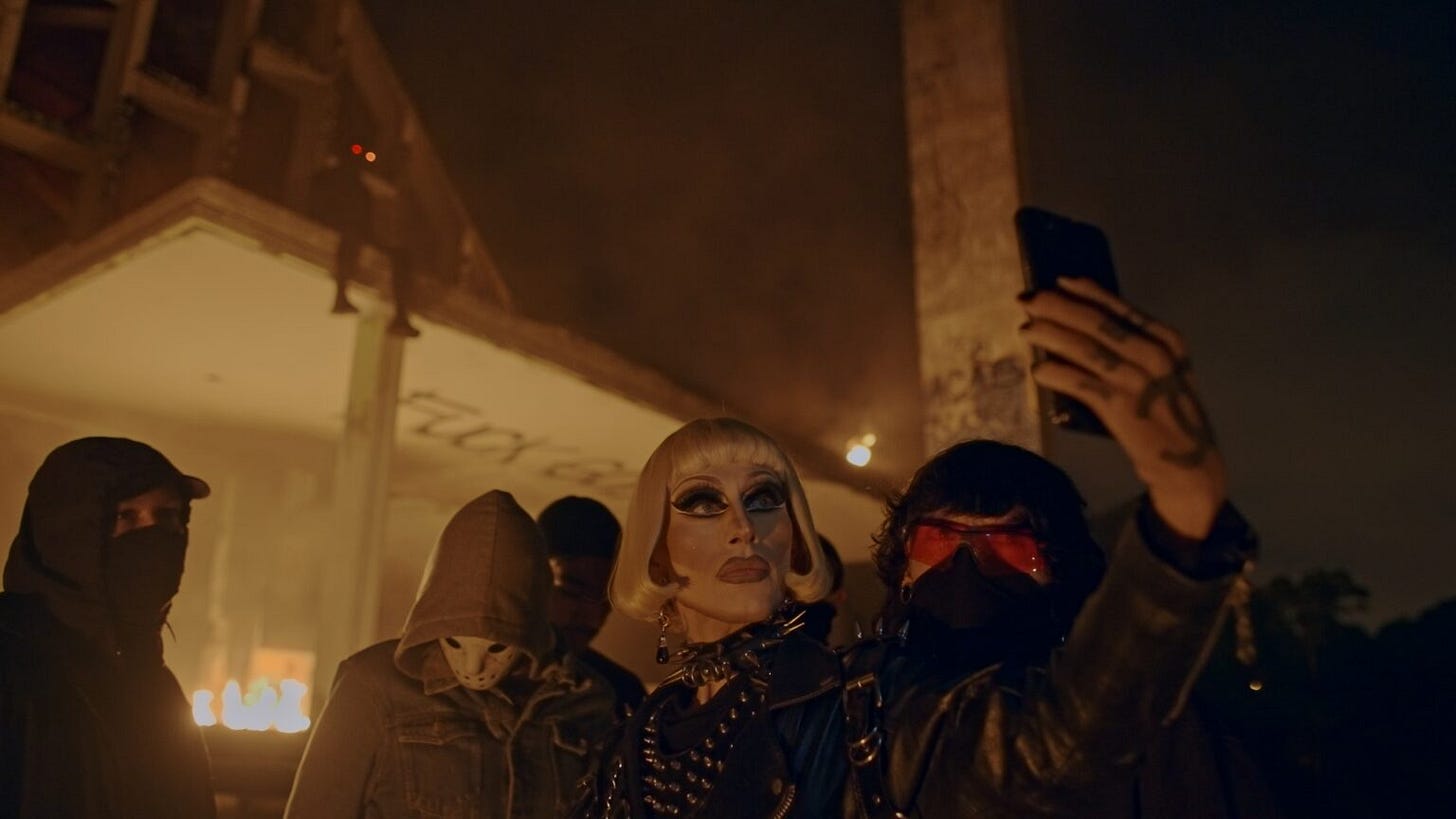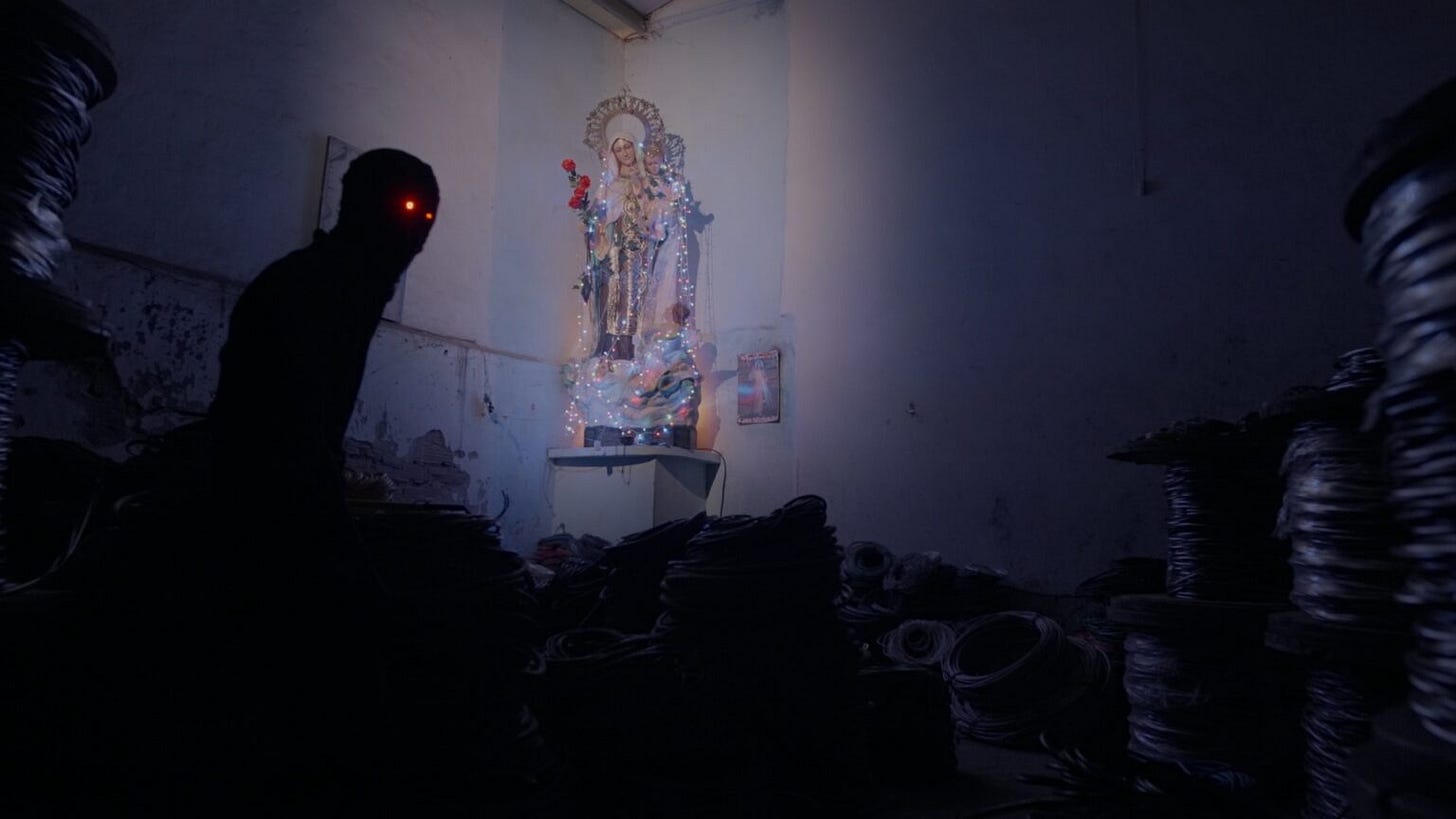09: Anhell69
On Theo Montoya's Anhell69 (2022), and on documenting the lives of dead friends.
“I don't think there is a future; the present is what there is.”
“I didn’t decide to be born,” says Theo Montoya morosely in the opening lines of narration of his film Anhell69, talking flatly over glossy images showing streetlights streaking over the upholstery of a vehicle that is revealed, moments later, to be a funeral car. “I was thrown into the world,” he adds, and, appropriately, his film also feels like it has been flung headfirst into existence, arriving in a shape that is impressively fully formed for a first feature. Earnest and impassioned, it is the sort of film that was obviously cathartic for its maker, a therapeutic object loaded with a broad spectrum of emotions spanning from desire, joy, and excitement, to rage, depression, grief, and pain.
Structured as a making-of documentary for a fiction feature that was never made, the film has an unusual shape. Montoya serves as narrator, playing a version of himself and describing first his backstory and then outlining this project-that-never-was by introducing the cast of characters that inspired its production and the context of the city in which they all live. As the film continues, the form expands outwardly, starting first as a work of autobiography and autofiction, then next becoming a character portrait made out of screen-test-like interviews with Montoya’s friends (mostly young queer men, several of whom are now dead), before finally developing into a diary film that folds in fiction elements in a magical realist mode.
Set in Medellín, the second largest urban area in Colombia and somewhere that has historically been considered one of the world’s most dangerous places to live, the film is immediately grounded in the specifics of the region. “I grew up in this city,” says Montoya, a “cemetery” he describes as “the mecca of homosexuality” in the country, but also the “mecca of Pablo Escobar”—the cartel leader, drug lord, and politician who, despite dying two years before Montoya was born, continues to affect the culture and politics of the city that the filmmaker calls home. Introducing his circle of friends, Montoya talks of a “generation raised by women”—men without fathers who came of age in a ghostland of fear, violence, intimidation, bigotry, and religious zealotry, but, despite this, helped to build the city’s vibrant queer culture and thriving club scene. From the start, the presence of death is palpable in Montoya’s Medellín; his narration constantly situates the experience of living in the city as being not only proximate to death but in communion with it—always aware that it’s not just an inevitable horizon but something that can arrive without warning, at any time.
This feeling defines the film’s fictitious sequences, interspersed moments of genre narrative that would have formed the basis of the full feature film that Montoya’s friends are seen auditioning for. A “class B ghost story” set in a version of Medellín where there is no longer any room for the dead in the city’s cemeteries, in the sequences seen in Anhell69 which Montoya contextualises in his narration, red-eyed, Uncle Boonmee style ghosts roam the streets—a situation that the filmmaker describes as “a metaphor for the reality we are living.” In this landscape, a new proclivity emerges, spectrophilia, in which a section of the living has sex with the walking dead. The state and clergy look to clamp down on this, deeming it perversion, and a battle breaks out between the central government and the people. Given that the film was never completed, how this plays out in the narrative is not made apparent, but as a somewhat blunt metaphor for the lives of the real “angels living in a hell of desires” from whom Montaya took inspiration, its function is clear. Per the 2016 peace agreement, Colombia’s long-lasting civil war may be theoretically over, but violence and persecution continues in a country that has, according to Montoya, “never known peace,” particularly affecting the most marginalised and vulnerable citizens. Standing in for the fiction feature he didn’t make, Montaya’s documentary serves as a beautiful “audio-visual record of his friends,” but also, in some cases, as the haunting final testimony of individuals left forever young on film.
Rather than being maudlin, Montoya uses excess as a strategy to convey the pain that comes with regularly losing friends to overdose, disease, murder, or suicide. Growing up wanting to be a priest, Montoya explains that he was excommunicated at thirteen for admitting to masturbating to the image of Christ. Instead, he found his salvation in the cinema, “the only place [he] could cry,” watching the films of Víctor Gaviria and other Colombian directors like Marta Rodríguez, Luis Ospina, and Carlos Mayolo, and shaping his identity in the image of the lurid visions he witnessed in Medellín’s film theatres and in the streets onto which they spilt out. As such, the film’s visual language is bolder and more outlandish than is seen in a lot of non-fiction films, using bright neons and stark red-blue strobes for club and street scenes which contrast well with the more austere interview sessions that see the subjects sat on black plastic chairs and lit by office-style overhead white strip-lighting.
Sequences dart one into another, switching style and format freely, moving from crisp high-definition to rougher, early-grade digital, mixing in scrappy archival materials lifted from news broadcasts or the web. The result is something mutable and collage-like, and yet oddly coherent—a patchwork film in which the pieces are aligned by tone more than style, stitched together by a continual current of techno-soundtracked darkness that runs through a film shot mostly indoors or during nighttime. “Sometimes I feel that my reality is conditioned by the traumas and the things I’ve gone through,” says Montoya at one point. His debut film is defined by his upbringing, the circles he moves in, and his knowledge of the city in which he has lived all his life. As such, it has the authenticity of direct experience and the gravity of everything being so close to home. Importantly, given that the film is as much about tribute as it is about testimony, it also means he knows how to make everything look beautiful too.
Anhell69—named after the Instagram handle of Camilo Najar, one of the film’s main participants and one of the eight young people commemorated in the film’s end credits who died between the time of the filming and the end of the editing phase—is a bleak, anhedonic film, made heavy by its prevailing feeling of total hopelessness and disaffection. In one sequence, the cast of nihilistic characters are asked for their thoughts on the future. No one can predict their future, and they struggle to imagine one for themselves either. Instead, they claim they just try to live for today. “The whole concept of the future can be like an illusion,” says one man, uneasy at the question. “A country like this takes away your hopes and your expectations,” he continues, putting the film’s sense of ambient despair in more literal terms.
Montoya’s solution for this community-wide dejection is creative, and within the film’s context of loss and bereavement, very moving too. In a bold move for a debut film, the filmmaker kills himself, revealing that the hearse (driven, in a nice cameo, by Víctor Gaviria) seen in the opening sequence is bearing his narrator-character’s body. Having arrived at the destination, Montoya shows his likeness being slowly lowered into the ground and buried, a gesture that presumably acts to put to rest his ill-fated fiction feature project alongside all of its baggage too. With this deed done, he then depicts a utopia in the form of a series of surreal tableaux featuring sets of individuals posing for stylised group portraits, imagining a world in which his friends are present, together, safe, and comforted, giving them the joyous future they are not able to conceive. In the creation of this limbo space shared “with beings, with animals, with insects” that exists away from the horror of real life, Montoya bypasses his planned fiction film’s metaphorical depiction of Medellín’s very real problems and moves from the depressing limits of representation towards the more expansive and hopeful space of speculation.
Theo Montoya’s Anhell69 (2022) screened at various festivals including Venice Critic’s Week 2022, IDFA 2022, CPH:DOX 2023, and True/False 2023. More information about Theo Montoya can be found here. To receive more articles like this, please subscribe. The writing in this newsletter will always be free-to-read, but donations are very welcome.



